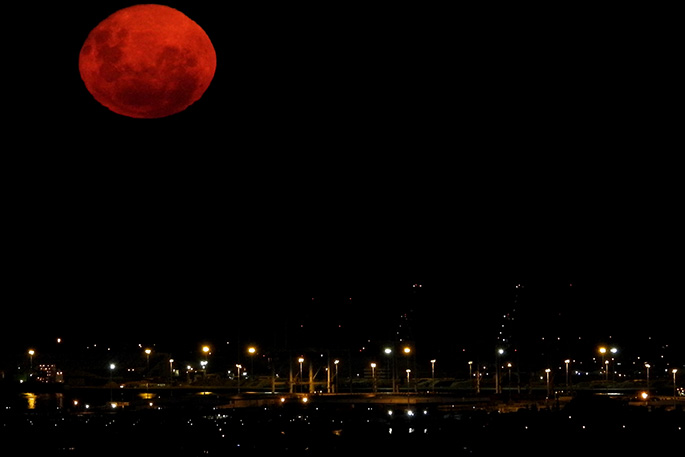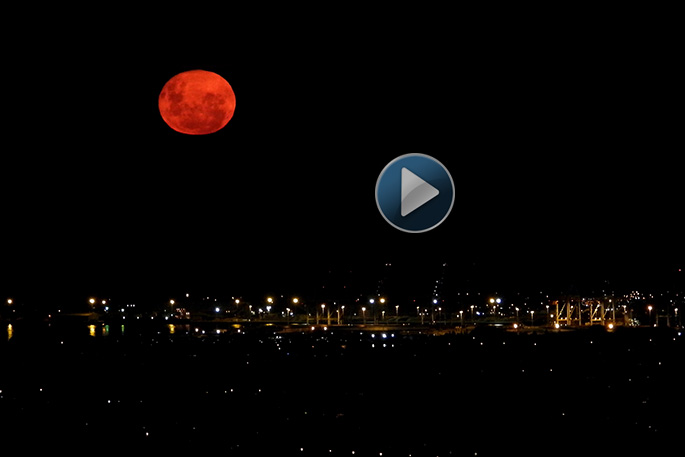On Saturday night, Dave Greig, who is the president of the Tauranga Astronomical Society, headed up to the Minden Lookout at Te Puna to see if he could film the moonrise.
The night sky was clear of cloud, and around 9pm the full moon of January, also called the Wolf Moon, appeared and started to float up from the horizon like a glowing pumpkin.
'This red Moon is not a ‘Blood Moon' or the result of a lunar eclipse,” says Dave. 'It is simply due to the fact that the Moon is low in the sky and is affected by ‘Rayleigh scattering', caused by refraction of the light as it passes through the atmosphere.”
Rayleigh scattering, named after the nineteenth-century British physicist Lord Rayleigh, is the predominantly elastic scattering of light or other electromagnetic radiation by particles much smaller than the wavelength of the light.
Lord Rayleigh published a paper describing the phenomenon in 1871.
For those interested in the history behind Rayleigh scattering, in 1859, while attempting to determine whether any contaminants remained in the purified air he used for infrared experiments, John Tyndall discovered that bright light scattering off nanoscopic particulates was faintly blue-tinted. He conjectured that a similar scattering of sunlight gave the sky its blue hue, but he could not explain the preference for blue light, nor could atmospheric dust explain the intensity of the sky's colour.
In 1871, Lord Rayleigh published two papers on the colour and polarization of skylight to quantify Tyndall's effect in water droplets in terms of the tiny particulates' volumes and refractive indices. In 1881 with the benefit of James Clerk Maxwell's 1865 proof of the electromagnetic nature of light, he showed that his equations followed from electromagnetism. In 1899, he showed that they applied to individual molecules, with terms containing particulate volumes and refractive indices replaced with terms for molecular polarizability.
'Rayleigh scattering is the same thing that causes the Sun to look orange/red when it is setting or rising,” says Dave. 'The smoke from the Australian wild fires will certainly make the Moon look more orange/red than normal.”

The full moon happens about once every 29.5 days, when the Moon and the Sun are on exactly opposite sides of Earth. It takes about 27 days for the Moon to orbit the Earth once but owing to the Earth's own motion around the Sun, from Full Moon to Full Moon is longer at 29.5 days. The word "month" – moonth - comes from ‘Moon'.
The Moon looks illuminated because we see the sun's light reflected from it, and because the Moon's rotation period is the same as its orbital period, we always see the same face of our satellite world from Earth.
In the Northern Hemisphere at the moment, observers will be seeing the Moon relatively high in the sky.
The Moon's height in the sky is largely dictated by its orbital tilt of about 5.15° with respect to the plane of the Earth's orbit about the Sun. which means that the Moon's position is changing month after month, sometimes rising further North and crossing lower in the sky, sometimes rising further South and crossing higher in the sky.
Dave and other members of the society can often be found filming all manner of interesting lunar and solar events, and also provide interesting talks and information at the Tauranga-based astronomy meetings.
Public meetings for the Tauranga Astronomical Society are held in the Observatory meeting room, Otumoetai Sports Club, at Fergusson Park at 7.30pm on the second and fourth Tuesday of every month. Presentations are given on current astronomical topics and all those interested in astronomy in the Bay of Plenty district are invited to attend. Weather permitting, there may be opportunities for viewing sessions through the club's 14 inch Meade LX200 telescope, 10 Dobsonian telescope, and 8 inch Meade telescope. Admission is $5 for visitors, and free for members and school age children.
The first meeting of the year for the Tauranga Astronomical Society will be on Tuesday February 11 at 7.30pm at the Tauranga Observatory at Fergusson Park, Matua. Follow them on Facebook here.
Tonight's full moon will be nearly an hour later than last night, starting to appear on the horizon at 9.58pm.



0 comments
Leave a Comment
You must be logged in to make a comment.